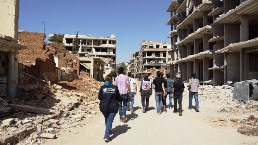 2 October 2016 – Since the beginning of the conflict in Syria, civilians have been denied access to life-saving and basic services, including health services, in specific areas inside the country. As of July 2016, the number of people in need living in hard-to-reach and besieged areas is 5.47 million people, including 590 200 in besieged locations and approximately 4.88 million in hard-to-reach locations. The number of people in besieged locations has increased by 103 500 since January 2016.
2 October 2016 – Since the beginning of the conflict in Syria, civilians have been denied access to life-saving and basic services, including health services, in specific areas inside the country. As of July 2016, the number of people in need living in hard-to-reach and besieged areas is 5.47 million people, including 590 200 in besieged locations and approximately 4.88 million in hard-to-reach locations. The number of people in besieged locations has increased by 103 500 since January 2016.
In many besieged areas, gross shortages of medical personnel, severe acute malnutrition, starvation and deaths have been reported. Since the second week of July 2016, there has been a serious deterioration in the health situation in the besieged eastern part of Aleppo city, with complete restriction of access for humanitarian and health aid, and frequent attacks on health care workers and facilities. Only 35 doctors remain for the more than 250 000 people in this part of the city and almost 80% of hospitals are out of service or only partially functional.
The UN Security Council has issued a series of resolutions calling parties to the conflict to allow unhindered access to all people inneed, in particular in all besieged areas. These same resolutions expressed concern about continued restrictions on medical care and reiterated the need to respect medical neutrality and facilitate free passage to all areas for medical personnel, equipment, transport and supplies, including surgical items.
Access restrictions imposed by parties to the conflict constitute one of the main impediments to WHO’s response operations in Syria. Since the beginning of the year, 21 out of 29 requests by WHO to access 93 locations in 11 governorates remain unanswered by national health authorities.Even when access has been permitted, attempts by WHO and partners to deliver aid are deliberately obstructed or delayed, and medical and surgical suppliesare routinely removed from aid convoys.
Despite challenges facing WHO and health partners, some progress has been made in reaching hard-to-reach and besieged populations. By August 2016, WHO and partners had successfully delivered medicines and health supplies from inside Syria to all 18 besieged areas across the country, many ofwhich had been restricted in terms of access since 2012. However, 38 out of the 52 convoys transporting medicines and medical supplies had some essential medicines and surgical supplies removed by national security.
From January to August 2016, WHO participated in 52 inter-agency convoys to besieged and hard-to-reach locations, delivering 200 tonnes of medical and health supplies, sufficient to provide a total of 2 million medical treatments*, including standard health kits, life-saving medicines for treatment of chronic diseases, medical instruments and equipment.
Through 28 separate cross-line missions to hard-to-reach locations, WHO was able to provide an additional 35 000 treatments, mainly for the treatment of chronic diseases. Overall, WHO delivered 58% of lifesaving medicines and treatments to people in need in hard-to-reach and besieged locations during the first quarter (Q1) of 2016 compared to 30% in previous years. However, the worsening security on the ground and limited access for interagency convoys only enabled the delivery 25% of medicines and treatments during Q2 2016.
Cross-border assistance from Turkey to northern Syria ensured the provision of medicines and medical supplies sufficient for 950 000 treatments from January to August 2016, more than half the deliveries going to hard-to-reach and besieged areas. Due to the suspension of cross-border operations to southern Syria from Jordan in June, 16 facilities ran out of essential medicines. The border temporarily re-opened on 28 July, when WHO was able to facilitate a shipment of 11.7 tonnes of medication for the International Rescue Committee. This shipment helped cover the needs of 12 of the facilities that had insufficient stocks. In August, WHO successfully delivered 49 surgical supply kits to 25 health facilities in Dar’a and Quinetra. Each kit is designed to support 100 surgical interventions and operations for 10 days.
Continuous access to Syria through Jordan and Turkey is critical to ensure the delivery of essential medicines and supplies into Syria, as well as to facilitate training for health professionals based in northernand southern Syria.
Sustained and unhindered cross-line and cross-border accessis also required for continuous assessment of the health situation and functionality of health facilities in Syria. This is especially relevant in areas where facilities have been damaged or destroyed. Referrals for patients in hard-to-reach and besieged locations in need of immediate and advanced medical care must be allowed, including guaranteeing safety and security fortheir return.
Access for immunization activities against vaccine-preventable diseases among children in all hard-to-reach and besieged locations is also imperative. Finally, the provision of life-saving medicines and essential medical supplies to people in hard-to-reach, opposition-controlled and besieged areas is required to strengthen health care service delivery in areas facing shortages of medical personnel.
For these objectives to be achieved, WHO and the health sector need the continuous support of all stakeholders and members of the International Syria Support Group to solve the political issues that continueto obstruct current humanitarian efforts and hamper greater achievement inreaching the besieged and hard-to-reach populations.


